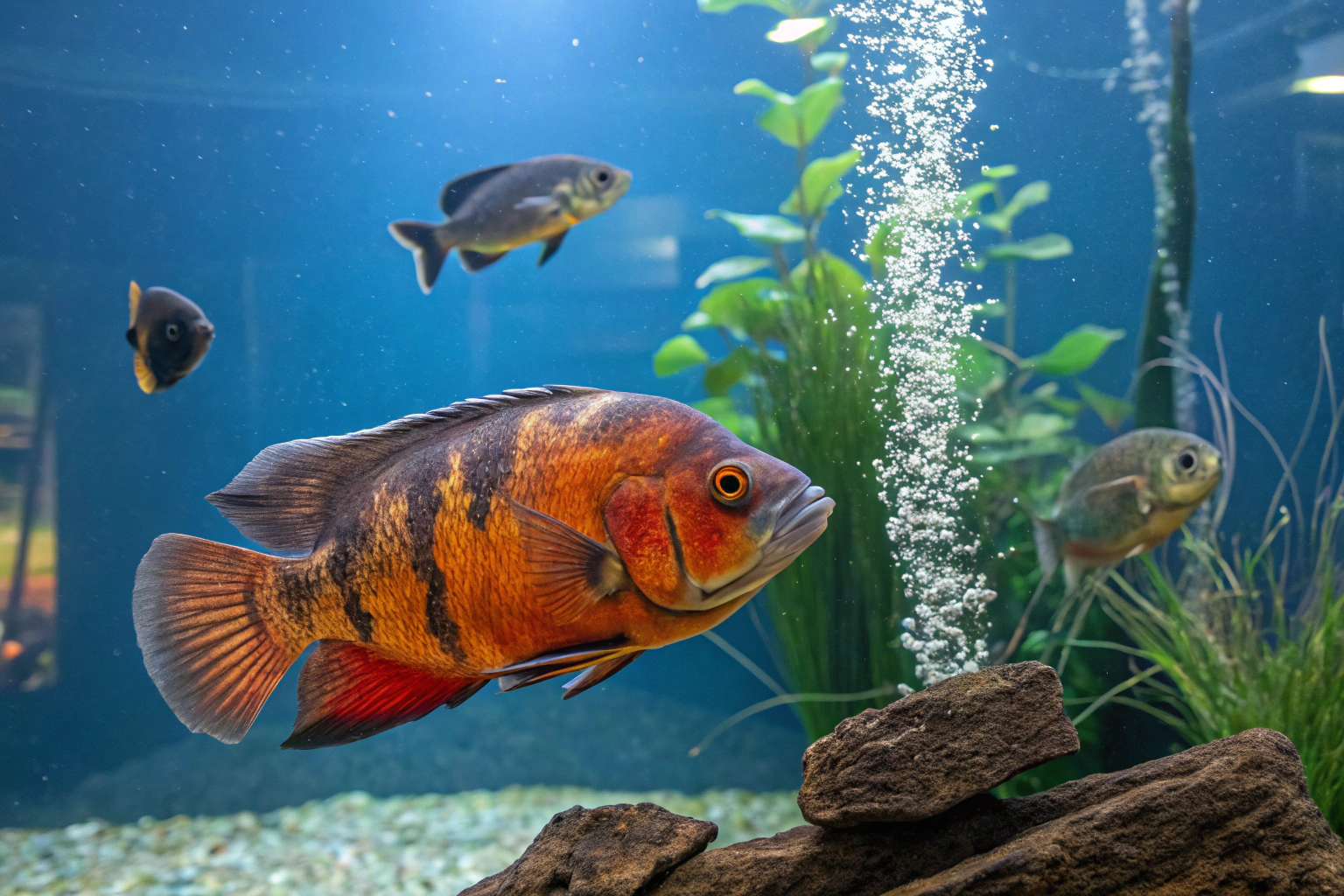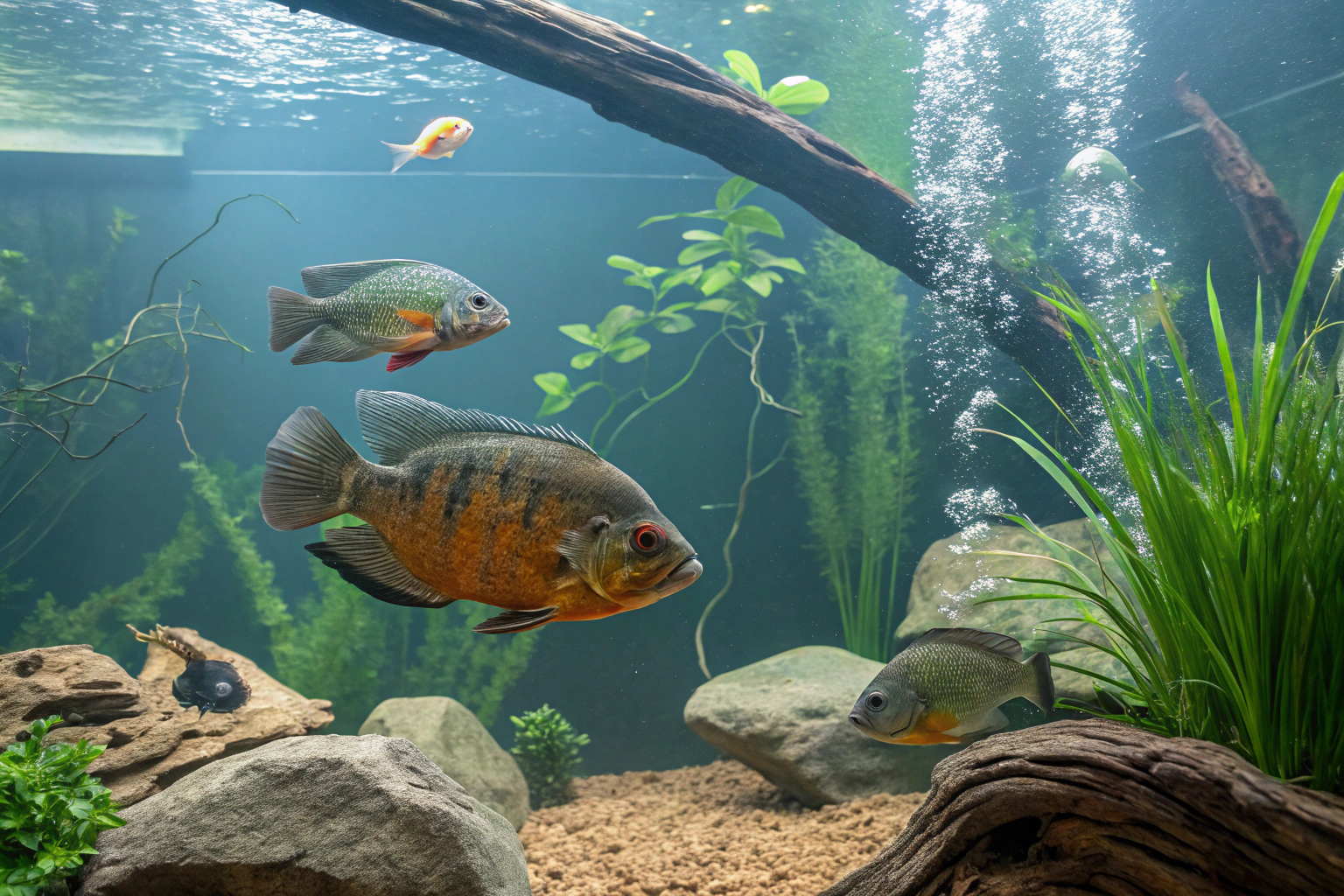What Fish Can Live With Oscars in the Same Tank? Complete Guide to Oscar Tank Mates
This post may contain affiliate links.
Oscar fish (Astronotus ocellatus) are among the most popular large freshwater aquarium fish, but finding compatible tank mates can be challenging. These South American cichlids are known for their intelligence, personality, and unfortunately, their aggressive tendencies. If you’re wondering what fish can live with Oscars, this comprehensive guide will help you create a harmonious community tank.

Understanding Oscar Fish Behavior and Requirements
Before selecting tank mates for your Oscar fish, it’s crucial to understand their natural behavior and tank requirements. Oscars are semi-aggressive cichlids that can grow up to 12-14 inches in length, requiring substantial space and specific water conditions.
Oscar Fish Tank Requirements
- Minimum tank size: 75 gallons for one Oscar, 125+ gallons for multiple fish
- Water temperature: 74-81°F (23-27°C)
- pH level: 6.0-8.0
- Water hardness: 5-20 dGH
- Strong filtration: Essential due to heavy bioload
Oscars are notorious for their messy eating habits and territorial nature, especially during breeding season. They’re also known to rearrange aquarium decorations and uproot plants, earning them the nickname “water dogs” among aquarium enthusiasts.

Best Tank Mates for Oscar Fish
Large, Robust Fish Species
When selecting Oscar tank mates, size matters significantly. Fish that are too small will likely become expensive snacks. Here are the best options:
1. Green Terror Cichlids (Andinoacara rivulatus) Green Terrors are excellent Oscar companions due to their similar size (8-10 inches) and semi-aggressive nature. They can hold their own against Oscars while sharing similar water parameter requirements.
2. Jack Dempsey Fish (Rocio octofasciata) Named after the famous boxer, Jack Dempseys are tough enough to coexist with Oscars. These Central American cichlids grow to about 8-10 inches and have comparable temperaments.
3. Firemouth Cichlids (Thorichthys meeki) While slightly smaller at 6-7 inches, Firemouths are quick and assertive enough to avoid Oscar aggression. Their vibrant coloration adds visual interest to the tank.
4. Silver Dollars (Metynnis argenteus) These peaceful schooling fish work well with Oscars when kept in groups of 5-6. Their size (4-6 inches) and quick swimming ability help them avoid confrontation.
5. Common Plecos (Hypostomus plecostomus) Large plecos make excellent tank mates as they occupy different water levels and provide beneficial algae control. Choose specimens over 8 inches for best results.
Other Compatible Species
Convict Cichlids: Though smaller, their aggressive nature helps them establish territory Severum Fish: Peaceful temperament but large enough to avoid predation Blue Acara: Hardy cichlids with similar water requirements Large Catfish Species: Bottom-dwellers that generally avoid conflict
Fish to Avoid With Oscars
Understanding what fish cannot live with Oscars is equally important for maintaining a healthy aquarium ecosystem.
Small Fish Species
- Neon tetras, guppies, and other small community fish will become food
- Any fish under 4 inches is at risk of predation
- Even medium-sized fish (4-6 inches) may be targeted during feeding frenzies
Highly Aggressive Species
- Red Devil cichlids and other extremely territorial fish
- Fish that compete directly for the same territory and resources
- Species with dramatically different water parameter needs
Delicate or Slow-Moving Fish
- Angelfish (too delicate despite their size)
- Discus fish (different water requirements and temperament)
- Long-finned varieties that may be nipped
Setting Up a Successful Oscar Community Tank
Creating a thriving Oscar community tank requires careful planning and proper setup techniques.
Tank Size and Layout
A minimum of 125 gallons is recommended for an Oscar community tank. The additional space helps reduce territorial disputes and provides adequate swimming room for all inhabitants. Use rocks, driftwood, and artificial plants to create territories and hiding spots.
Filtration and Maintenance
Oscars produce significant waste, requiring robust filtration systems. Consider:
- Canister filters rated for 2-3 times your tank volume
- Regular water changes (25-30% weekly)
- Adequate biological filtration media
- Protein skimmers for heavily stocked tanks
Feeding Strategies
Proper feeding reduces aggression and maintains water quality:
- Feed multiple small meals rather than one large feeding
- Use high-quality cichlid pellets as the staple diet
- Supplement with frozen foods like bloodworms and brine shrimp
- Avoid overfeeding to prevent water quality issues
Monitoring Tank Dynamics
Successfully keeping Oscars with tank mates requires ongoing observation and management.
Signs of Compatibility Issues
- Constant chasing or aggressive behavior
- Torn fins or visible injuries
- Fish hiding constantly or refusing to eat
- Dramatic changes in behavior patterns
Intervention Strategies
If compatibility issues arise:
- Rearrange tank decorations to disrupt established territories
- Separate aggressive individuals temporarily
- Ensure adequate feeding to reduce food competition
- Consider rehoming incompatible fish if necessary

Water Quality Management for Oscar Communities
Maintaining excellent water quality becomes even more critical in community tanks with large, messy fish like Oscars.
Testing and Monitoring
Regular testing of ammonia, nitrite, nitrate, and pH levels is essential. Oscar community tanks often require:
- More frequent water changes than single-species tanks
- Enhanced biological filtration
- Careful monitoring of bioload limits
- Quality water testing kits for accurate readings
Common Water Quality Issues
- Ammonia spikes from overfeeding
- Nitrate accumulation requiring increased water changes
- pH fluctuations from biological processes
- Oxygen depletion in heavily stocked tanks

Breeding Considerations in Community Tanks
Oscar fish become significantly more aggressive during breeding season, which can disrupt established community dynamics.
Managing Breeding Behavior
- Provide additional hiding spots for other fish
- Monitor for increased aggression and territorial behavior
- Consider temporary separation if breeding pairs become overly aggressive
- Understand that successful breeding may require species-only setup
Long-term Success Strategies
Maintaining a successful Oscar community tank is a long-term commitment requiring patience and flexibility.
Growth Planning
Remember that many fish continue growing throughout their lives:
- Plan for adult sizes when selecting tank mates
- Be prepared to upgrade tank size as fish mature
- Monitor growth rates and adjust stocking accordingly
- Consider the 10-year+ lifespan of properly cared for Oscars
Equipment Upgrades
As your fish grow and your experience increases, you may need:
- Larger or additional filtration systems
- Upgraded heating and lighting systems
- Enhanced water testing and monitoring equipment
- Emergency backup systems for power outages
Conclusion
Successfully keeping Oscar fish with compatible tank mates requires careful species selection, adequate space, and ongoing management. The best Oscar tank mates are large, robust fish that can hold their own without being overly aggressive. Species like Green Terrors, Jack Dempseys, and Silver Dollars offer the best combination of compatibility and visual appeal.
Remember that every fish has individual personality traits, and what works in one tank may not work in another. Start with well-researched species combinations, maintain excellent water quality, and be prepared to make adjustments as your aquatic community develops. With proper planning and care, you can create a stunning Oscar community tank that provides years of enjoyment.
For more detailed information about cichlid care and compatibility, consult specialized aquarium resources and experienced aquarists in your local community. Success with Oscar tank mates comes from combining knowledge, patience, and careful observation of your fish’s behavior and needs.
